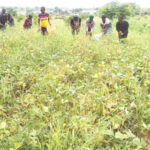Kem village is one of the farming communities known for cotton production in Adamawa State.
It is located in Shelleng Local Government Area. The cotton production belt stretches to neighbouring Gombe State.
Many years ago, most of the farmers abandoned cotton production for soybeans and sesame because of low yield and poor access to market hinged on lack of access to improved/quality seeds and the apparent collapse of the textile and garment industries in the country.
But in 2019, some farmers were introduced to two Bt. Cotton hybrid varieties and the yield has brought many back to cotton production this year with more hoping to join in the 2020/2021 planting season.
The two bollgard II varieties are Mahyco C 567 BG2 and 571 BG2.
The first is for medium duration (160 to 170 days) with big boll size, while the second is an early duration (150 to 160 days) hybrid with good tolerance to sucking pests.
The two varieties are also resistant to bollworm, and yield up to 4.1-4.4 tons/hectare respectively and produce good fibre strength/quality cherished by textile industries.
Daily Trust caught up with some farmers harvesting their cotton in the fields last week where they shared their experiences having returned to cotton production using the new seed varieties, and their expectation for the future.
Mr. Joshua Dadi, 51, has been cultivating cotton in Kem village for about two decades using the local varieties, which he said gave between 600kg and a maximum one metric ton per hectare.
“But it was just last year that I started farming the Bt. Cotton varieties when they were given to us to try. I cultivated it in 80 ridges, which was less than a hectare and I got 2.4 tons.
“I made over N500,000. I was very surprised and happy.
“This year, I increased the farm to three and a half hectares,” Dadi told Daily Trust.
Already, he’s harvesting and his expectation is high. With a ton currently selling at N180,000 (about US$450), he hopes to make more than N3 million this year.
Many villagers, particularly women and their families, are also increasing their income picking cotton at N30 per kg as farm workers.
Another farmer, Mr Bala Sarkin Ruwa, told this reporter how the Bt. variety he planted performed: “If you entered my farm last year, no one would see you.
“The plant grew so tall and produced a lot of bolls. In one plant, I counted 480 bolls.”
This year, however, the performance has not been as good as last year’s because of erratic rainfall making him replant.
Despite these challenges, he said: “This variety compared to the local ones that I planted previously, is better.
“In terms of labour, you won’t labour so much like those ones (referring to the many times of pesticides application). In terms of insects or pests, this one is bollgard.”
Sarkin Ruwa said the two Bt. varieties gave him up to four tons (4,000kg) per hectare, adding that with the local varieties, the most he got was one ton per hectare, adding that usually, it was between 300kg to 800kg.
Mrs. Victoria Chindiga, 45, a mother of 7 said she became a cotton farmer by inheritance because she grew up and saw her father growing cotton as the best farmer in the village but had to stop at a point because of the problems around cotton production. However, she has resumed cultivation this year.
“This year we bought bollgard, which we planted and it was good and we have started harvesting it already.
“Truly the cotton variety is good; we are hoping that the new varieties would be made available and cheaper,” Mrs Victoria said, adding that she plans to expand her farm to at least 1.5 hectares next season.
Also for younger farmers like Mr Adamu Kulmy, 31, the new hybrid seeds have brought relief. “We were suffering using the local varieties with little or no gain at times,” he said.
Speaking on the current market value of cotton, Mrs Jacob Vocks, a 60-year-old farmer who has been into cotton farming for the past 20 years said even if the current selling price of N180,000 to N190,000 is considered low, “you can still farm the cotton and make a profit.”
He is optimistic that the market price will go up in the nearest future.
However, unlike 2019, this year the farmers complained of two major issues; the first has to do with the cost of the seeds while the other has to do with germination rate.
The agric experts however largely blame farmers’ inability to observe the planting depth requirement because of their soil type.
The farmers are concerned that the seeds are a bit expensive, selling at N11,000 per kg.
That, too, the officials blamed on the cost of shipping from India at a time many countries were under the COVID-19 lockdown.
Dr Amos Phiri of Mahyco Nigeria, the seed company licenced to produce and distribute seed, while speaking on some of the issues, said if one did a comparative analysis of the cost of seed against the yield and the revenue, it will show that the farmer is more advantaged.
Dr Phiri, who provided extension services to the farmers, while speaking on the issue of germination said: “In the next phase of our programme, coming up next season, we intend to educate the farmers earlier through the module of how to plant the right way. So we would start the extension services prior to the time they buy the seeds.”
While answering questions on the attitude of farmers to the Bt. Cotton, he said: “The attitude is improving towards a positive direction because a lot of them abandoned cotton for soybeans.
“Kem as a community is known for cotton but when cotton lost its commercial value, they looked at soybeans and sesame as a close-by alternative because they always have the buyers very close to them.”
This year, the farmers bought just 1.2 tons of Bt. Cotton seed because it came late. However, Dr Phiri said from now till March 2021, they would target to sell up to seven tons with the enthusiasm he saw in the farmers, adding that they are ready for that because once they realise the potentials of the seeds, they would go for it the more.
With cotton picking up again, stakeholders are mounting pressure on the federal government to revive the textile and garment industries.
Mr Kwajaffa said the Bank of Industry (BoI) and the CBN should fund the industries to acquire modern technology of producing high-quality fabrics, not only for the country’s consumption but also for export.
On its part, the Raw Materials Research and Development Council (RMRDC), has described the declining performance of the Cotton, Textiles and Garment (CTG) sector in Nigeria as extremely worrisome.
The agency said it was disheartening to note that out of the 54 ginneries available in Nigeria, only 22 are functioning at very low capacity utilization.
The capacity of the existing ginneries is about 650,000 tons of seed cotton but the current production is less than 60,000 ton per annum representing about 10% capacity utilization.
The trend affected the cotton value chain development culminating in the closure of 83 textile industries from 1995 to date.
The DG of the RMRDC, Professor Ibrahim Hussaini Doko, said the effects of these include job loss and unemployment and loss in foreign exchange earnings.
In the 1970s to the 1990s, the Nigerian textile industry accounted for about 25 per cent of the Manufacturing Value Added (MVA) of the economy as the largest employer of labour.
The sector employed about 650,000 people during its glorious era, in the 1970s to 1980s.
With the new energy and biotechnology introduced into cotton production, experts want government to look at ways of reviving the local industries.
One way to do that, they say, is to impose import restriction and local content for all fabrics used in thousands of schools, the armed forces and other para-military institutions such as the Customs Service, Correctional Service, Immigration Service, Civil Defence Corps, etc.

 Join Daily Trust WhatsApp Community For Quick Access To News and Happenings Around You.
Join Daily Trust WhatsApp Community For Quick Access To News and Happenings Around You.



